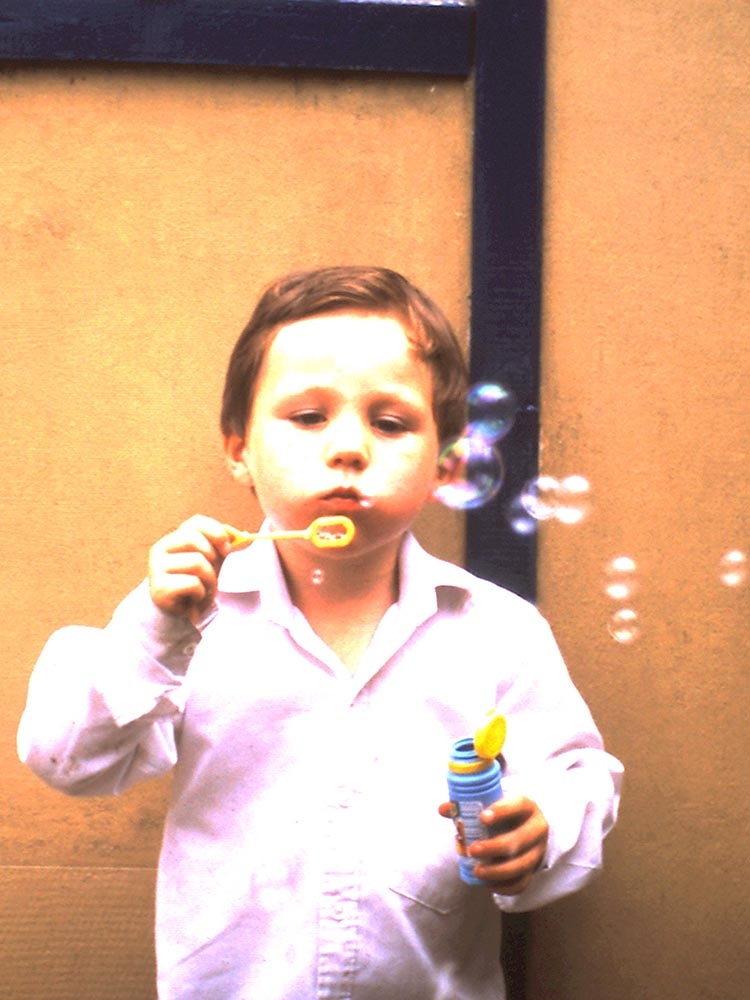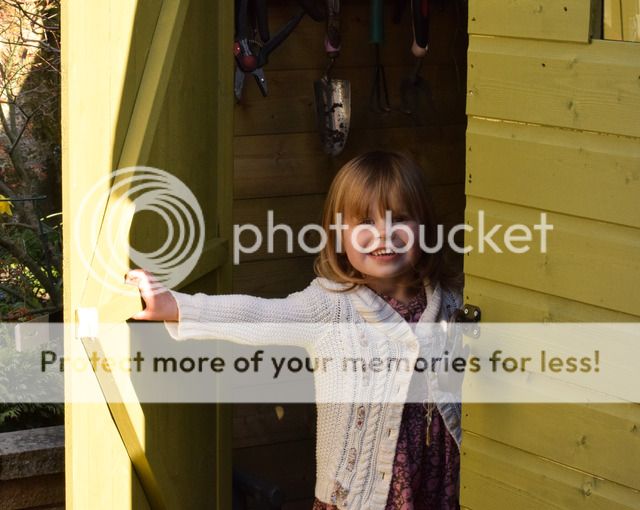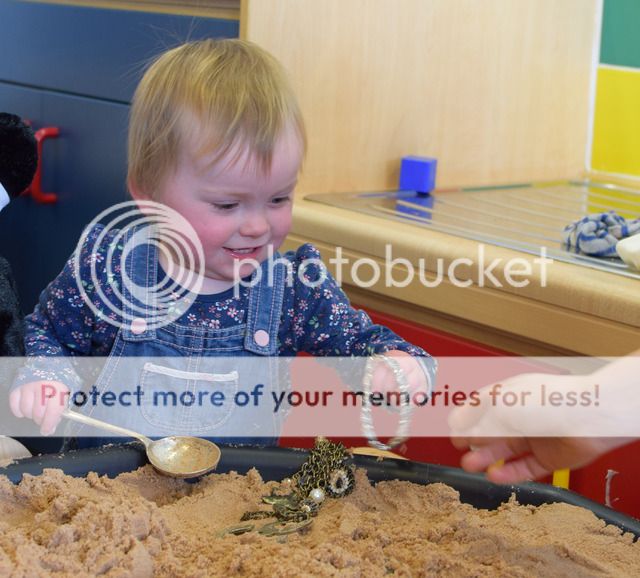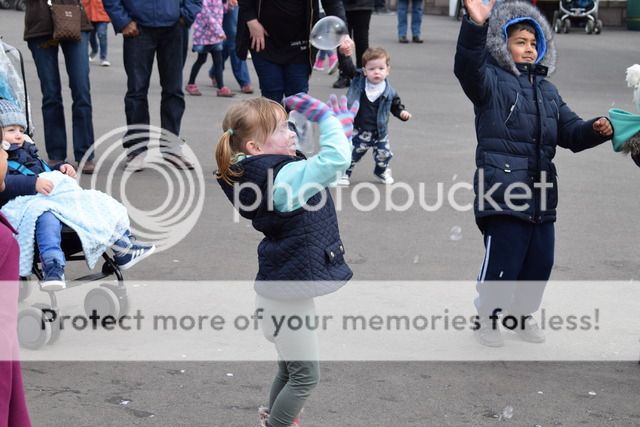Selective focus, OOF back-grounds? Does give a nice effect, doesn't it? This was taken in-doors, (a church hall if memory serves; it was the party after a Catholic Christening, so LOTS of kidz tearing about!), on film, probably 100ASA, many decades ago, with a little 'bounce' flash.
But it's an effect, that if you want to exploit, you really have to understand, and modern Auto-Focus cameras & lenses don't do much to help folk understand it these days, unfortunately.
Remember, the DoF you get around your focus point is a % of the focus-distance, so the closer you are to your subject, less DoF you get, regardless of aperture, so you can get it without using a long lens or wide aperture, just by getting that bit closer to your subject.
BUT, DoF extends 1/3 in-front of the focus point and 2/3 behind.... take note, you get more in focus behind your subject, than in-front... which is a little unhelpful if you are a slave to Auto-focus, because you focus on the eyes, and there's not a lot in the shot in front of them, other than the nose, or in this picture the fruit-punch in the girl's hand.... and if the back-ground is particularly close to the subject, you are going to struggle trying to throw that oof, just on the aperture..... BUT... using an old manual focus camera, you could 'cheat' and shift the entire DoF 'zone' and pull it forwards, by NOT focusing on the eyes; you focus on the girls nose, or on the glass, or even on 'nothing' somewhere in front of her.. now her hand, glass, nose eyes and ears are all still in the DoF zone and in acceptably sharp-focus, BUT the DoF is now dropping off much sooner behind the subject, and your close background going nicely oof that much sooner.
Old Manual focus lenses, as said, made this easier, as they they usually had focus distance scales on them, many modern AF lenses often lack, (and the Nik-Kit 18-55 & 55-300 are definite examples), and they also had DoF markings on the focus scale to indicate the DoF zone around the set focus distance for any aperture.
That picture was probably shot with a camera to subject distance of about 2m or 7ft. looking at the scale on my old Ziess 50, @ f8, that would give me a DoF zone from aprox 5&1/2ft to 10ft, so if I had focused on her eyes, I have a good 18" of focus in front of her, but almost 3ft behind... but I want what was behind oof.. there ent anything in front of her to in or out of focus!
SO I could focus in-front of her, by maybe a foot, and now my DoF zone is extending from about 5ft to 7ft... shortening focus has shortened the DoF.... I have a zone barely 2ft deep instead of 4&1/2 ft.. I have't actually got closer to the subject, but focusing as if had, has shortened the DoF, and by as much as opening up the aperture almost two stops! BUT far more 'usefully', I have shifted the DoF zone, so that most of it is 'around' my subject, and what I want in acceptable focus is, and probably more of it than if I had just opened up the aperture.. and that bit of the scene I want going oof, is now dropping out of the Dof zone that much sooner...
THIS is proper 'selective focus' rather than 'shallow Dof' effect. Actually exploiting the DoF to put the Depth-of-Focus zone 'around' what you want in focus, not arbitrarily 1/3 in front & 2/3 behind the focus point selected for you by a red-dot!
Like I said, modern AF cameras are rather unhelpful in exploiting 'selective focus' techniques, you might try messing with the focusing 'scheme' and which dot the camera uses, or using the back-button for focus lock, b-u-t.. a lot of 'faff' ad they wont focus on thin air, where you might actually want your focus distance set! So you probably have to switch off the AF altogether and go manual, where the lack of focus scale ad DoF markings is something of a hindrance.....
Old manual-focus film-cameras, could also often be stopped down to the taking aperture, and some eve had a DoF pre-view button to do that for you, so you could see the DoF through the view-finder, which modern electric picture makers that hold the aperture wide-open until the shutter is pressed, lack.. so it IS a tougher trick to master with a Digtal SLR than a old Film Camera.
Different little girl, slightly more recently. My O/H's grand-daughter, last year in the back-garden, in natural light; shot on digital with an old manual focus, M42 screw fit, Hanimex 135 'prime' lens, on an adaptor to fit the electric picture-maker.... again, exploiting the DoF zone to put the focus zone where I want it, for 'selective-focus' rather than 'shallow-focus'.
Going to annoy you a bit now, after you have spent £150 on the Nik 35mm AF-S f1.8 'prime'.... I have to admit, I bought that lens, and the AF-S 50mm f1.8 prime for my daughter for her school photography, and I have been sorely tempted to get another 35 for myself.... BUT, as alluded to, I bought a 'legacy adaptor' to take M42 screw-fit lenses, so that I could use some of my old manual-focus primes from film cameras, and I have a Pentacon 29mm f2.8, that has almost the same Angle-of-View, and is only a little slower on aperture; likewise the Ziess 50 that's also f2.8, then the 15 mentioned that's also f2.8.. notably faster that one than much in the AF arena with that sort of reach that doesn't cost thousands!But this lot cost me relative pennies!
I think I paid about £20 for the legacy adaptor to mount them to the DSLR. I bought the more expensive version that has an 'infinity correction element', as the adaptor, moving the lens forwards on the camera, like a macro-ring shifts the focus calibration, so they focus closer to the camera, but some wont focus on infinity without the correction element. I acquired my M42 primes over the years, years back; most often given to me by folk who didn't or couldn't use them or the cameras they were mounted on (lucky me!) or in the second hand shops for maybe a couple of quid, or tops a fiver a time! But even now, if you hunt e-bay, yo can get 'good' old manual focus lenses like these, for between perhaps £10 & £30. Even my beloved Ziess 50, would only command about £50 on the bay, but a faster f1.8 Pentacon 50 might only cost you £20-£25.. that's a LOT of lens for your money! And personally, I've confirmed the suggestion that these 'legacy' lenses for old 35mm cameras, are so much 'sharper' on a crop-sensor DSLR only taking a picture from the middle of the larger image circle, intended for a larger full-frame camera, as well as being a joy to use! Just think, you could have had an adaptor and a full set of good, fast primes for less than that Nikon AF-S 35! (sorry!)
Worth a thuk, though, if you DO want to learn how to exploit 'selective focus' rather than just 'shallow focus'.... as mentioned, you get manual focus lenses that demand you manually focus them where you want, not what the camera thinks you should, and that have both focus scales and DoF markings to help you put the DoF zone where you want it.
And for the learning? Well, actually having to manually focus, and put in a bit more effort, time and thought to focusing, THAT is what will encourage you to get what YOU want, and make the camera work for you, rather than simply hoping it delivers it for you.
I will say though, on my DSLR (D3200) not so sure about yours, using manual focus lenses that don't have any electronics in them to talk to the camera through the contacts on the mount, I can only use them in full Manual mode, and have to set the ISO, and shutter manually on the camera, and the aperture on the lens; I loose all 'automation' with them, AND the camera, not told what the aperture setting is by the lens, refuses to even offer 'exposure' metering.... Its like using my old Russian Zenit 35mm SLR! That has no metering either; had to estimate exposures by the f16 sunny rule, or use an independent hand-held meter, or get an exposure value off another 'metered' camera to use that one! I don't find it a big issue using the manual lens on the DSLR in the same way; but I can get a 'base' exposure value from it uing the kit lens before swapping to the legacy lenses, or I can chimp-it, or in parlance, 'suck it and see', taking a wild guess at exposure settings, taking a shot with them, and then looking at the preview on the screen on the back, and adjusting settings from there. That shot above, was actually 'metered' by guestimate from the f16-sunny rule, though... it was a bit of a 'grab'.. as in I had grabbed the camera, and it still had the legacy lens on it, and to get some pictures before the little squid ran off down the park or got covered in mud or anything, I did't have time to swap lenses to get a base metering, or faff trying to find the hand-held meter, so had to 'wing-it'..
Which is another bit of 'learning' these lenses have to offer. Far too many folk get far to hung up on their 'exposure' settings, and 'accurate exposures', which is frankly often irrelevant. There's no such thing as a 'correct' exposure, and what the camera suggests as its scientifically calculated 'best' exposure value, often isn't what looks 'best'.. and it probably doesn't matter a stop or so either way how 'close' it is! Learn to assess the light for yourself, and treat the cameras metering as a guide, not a rule.
However.... enough about the 'kit'.... lets talk KIDS. Infuriating little things that deplete your patience, your bank-balance and steal all your marbles; they dont sit still, they are governed by the laws of Brownian motion, not physics, and are generally put on this earth to drive you NUTS! Especially if you are trying to get a photo of one!
I think that was my daughter's 4th & my son's 3rd birthday party... yeah.... I actually quite like the blurr... it's very 'true' to the scene I was observing! Thirty three and four year old's and a bouncy castle in the Church hall! HELP! Give me alcohol! I NEED GIN! lol! By the end of the afternoon, I think they were probably all worn out and crabby, lying on the floor calling for their mummy.. but after enough gin they were STILL blurry ;-)
Photographing children is a discipline in itself. But, like most photo, the 'trick' is in the subject, not the camera. There is only SO much you can do, standing back, trying to hide in the
shadows ad capture them 'unobtrusively'.
If you want good kid-pix, then first you need to get into their world, and that means getting down to their level, crouching down on your knees or even lying down on the floor to see the world as they do from a low vantage point.. you wont get that, standing on the side-lines!
Taking that a step further; you have to REALLY get into the kids world; YOU have to forget that the other grown-ups exist... if you are worried that a pop-up flash will draw attention to you... you are NOT in the kids world! You have to think like the kids, they are 'playing' so YOU have to 'play', you have to chuck yourself into their world and like them, ignore the grown ups until one of them tells you off, or hands you a lolly!
You play with them; you engage with them, you talk to them! You let them accept you into their world.. and accept the camera.. and then ignore it!
You'll get very natural and intimate candids of them playing, around you, or with you, in which they will be amenable to posing for you.... either because you say "Hey, Megan!" and she looks at you, and the camera, and 'snap' you got'em, or you say, "Oscar! Why don't you kick that ball?" and they do, ad there's your shot.
Yup... its a BIT like herding cats... OK, its a LOT like herding cats! BUT, that's where the skill is to kids photography, like wedding photography or still life, its managing your subject; MAKING the photo's you want, not standing around hoping that they'll just happen, or that the camera will make them happen for you.
If you want to buy ANYTHING to help you take better kid-pix? Well....
Buy a bottle or three of soap-bubbles! LoL! It's the classic exercise in kid-photography. This shot's an early experiment; blown high-lights I think from having shot it on slide-film and then 'duped' it to colour-print; the model in this case my five year-old little bother, in the back garden, shortly after I got my first SLR.... But I tell you what, a bottle of soap-bubbles in my camera bag, got me more good kiddie pix than ANY amount of lenses or flash or filters. Actually, worked pretty good on a lot of grown-ups too!
It's about crossing that glass wall, and getting 'in' to your subjects world, rather than looking at it through the window of the view-finder.










